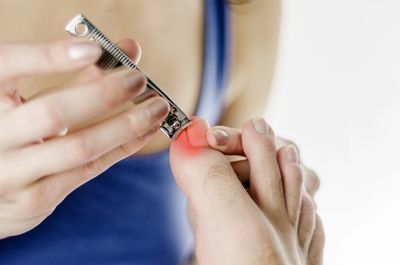Ingrown Toenail (Onychocryptosis): Treatment Overview
Definition:
An ingrown toenail occurs when the nail edge penetrates the periungual skin, causing inflammation, pain, and often infection. The great toe is most commonly affected.
Stages of Ingrown Toenail:
StageDescriptionCommon SymptomsIInflammation onlyPain, redness, mild swellingIIInfectionDrainage, pus, increased tendernessIIIChronic inflammation + granulation tissueHypertrophy of nail fold, severe pain
Treatment Options:
1. Conservative Management (Stage I):
- Soaking the toe in warm water or Epsom salts 2–3 times daily Epsom Salt Soak (3lb. bag)
- Topical antibiotics (e.g., bacitracin or mupirocin) Antibiotic Ointment. Bandaids
- Cotton wick or dental floss under the nail edge to lift it from the skin
- Wide shoes or sandals to avoid compression
- Oral antibiotics if mild cellulitis is suspected
2. Office-Based Procedures (Stage II–III):
a. Partial Nail Avulsion (Slant-Back or Wedge Resection):
- Local anesthetic applied (digital block)
- The offending nail border is removed
- Minimal disruption to nail plate if done properly
b. Chemical Matrixectomy:
- After avulsion, phenol (88%) or sodium hydroxide/alcohol applied to nail matrix
- Prevents recurrence by destroying the root of the nail
- Most effective for chronic or recurrent ingrown nails
c. Electrocautery or Radiofrequency Ablation:
- Less common, but an alternative to chemical cauterization
- Also targets the nail matrix
3. Surgical Management (Refractory or Advanced Cases):
a. Total Nail Avulsion:
- Removal of the entire nail plate
- Typically reserved for severe or infected cases
b. Winograd Procedure:
- Partial nail avulsion with excision of nail matrix and nail fold
- May require sutures and longer healing time
c. Vandenbos Procedure:
- Excision of excessive periungual soft tissue without removing the nail
- Useful in patients with redundant skin causing chronic ingrowth
Post-Treatment Care:
- Keep site clean and dry
- Use topical antibiotics
- Apply non-stick dressing until granulation heals (1–3 weeks)
- Wear open-toed footwear
- Follow-up to assess healing and recurrence
When to Refer or Escalate:
- Recurrent ingrown nails despite conservative care
- Diabetic or immunocompromised patients with signs of infection
- Severe granulation tissue or abscess formation

This website uses cookies.
We use cookies to analyze website traffic and optimize your website experience. By accepting our use of cookies, your data will be aggregated with all other user data.